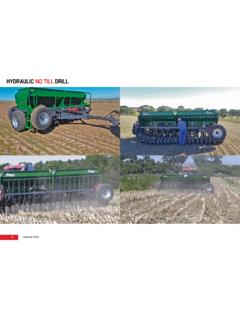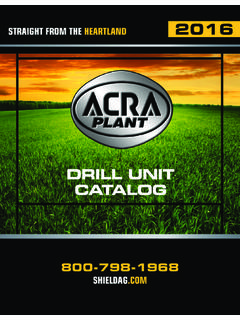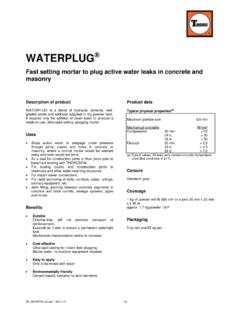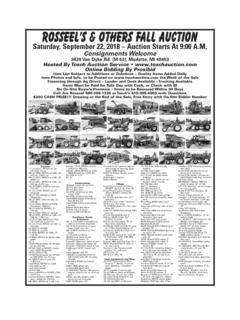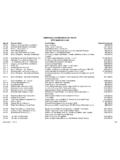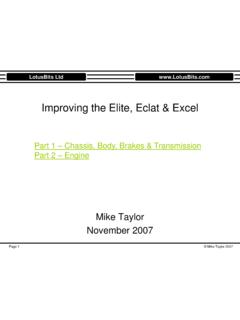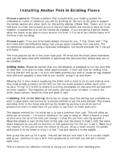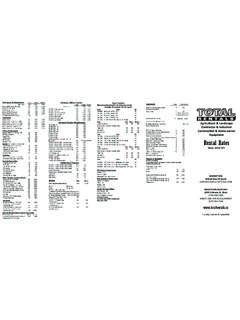Transcription of Dave Kamp’s book of IH Cub Cadet Modifications: U-joint ...
1 Dave Kamp's book of IH Cub Cadet Modifications: U-joint Driveshaft Dave Kamp's magic book of International Harvester Cub Cadet Modifications WHAT IS THIS modification ', AND WHAT PROMPTED THE DESIGN? First Answer: necessity. These darned pin-couplers worked, and most are still in service, but they wear and fail at what I consider to be a consumeable' rate. Frankly, I hate consumable parts that can't be removed through a drain-plug, using a and can't be replaced using a funnel and a few paper I. especially hate consumable parts that can't be changed in under 4 minutes. Oil and air filters, spark plugs, fuel, and oil are enough of a PITA, I'd rather put my tools to WORK, rather than WORK on them.
2 Not only am I a busybody, with an eternal to-do list, I'm also lazy- hate doing things that shouldn't've had to be done in the FIRST PLACE. You'll find, in reading through, that not only do these modifications improve the mechanical considerations of the machine, there's a few aspects where it actually makes maintenance easier, faster, Again- I'm a busybody, always working on something, but I HATE having to work on something that I just fixed the other day. May God bless Harold Schramm for introducing this Cub Cadet to the world- without it, I'd have no reason to be documenting what I've done, but worse yet, I'd have no Cubs to help me do all the work that I'd rather THEY bear the heaviest burdon of.
3 Harold was undoubtedly one of the nicest, sharpest guys I've ever met, and an extremely astute engineer in both terms of product design excellence, but also in Quality Control. There's three aspects of Quality Control- first getting quality HIGH enough to get customer next, getting quality NO HIGHER THAN what's necessary to meet the marketplace with a competetive product (that's profit). The LAST, is designing something so that it hits the UPPER level, at the cost of the LOWER. Example being: excess precision. People think that manufacturing parts is it's but manufacturing with PRECISION is VERY expensive. If you design something that requires substantial attention to precision, it may be a nice product, but it'll be not only too expensive to be competetive, it'll also be too finicky when in a varying environment.
4 Agricultural environments being what they are, the LEAST amount of precision is typically the best. Putting all these things together is what old- school engineers refer to as making successful design compromise'. In the realm of the General Consumer market, There's only a few natural weaknesses to the Cub the coupler is one of there's a few other minor things. We Cub Cadet enthusiasts, however, exceed the realm of Joe Consumer who was purchasing these things new between the 1960's and 80' we hang incredible amounts of ballast, hop up the engines, fit implements, and thrash them like a red-headed and these machines soldier on through it all, like they were intended to from the git-go.
5 In a perhaps sado- masochistic sorta way, we love but every so often, the steed gets an Achilles Heel. I purposely go looking for these heels', and find ways of resolving em. Follow along as I show you what, and how I've modified on my IHCCs to make some of the natural design compromises a little bit less compromising. As you're looking, keep in mind that Harold DID see most of these modifications before passing on, and noted to me if during his tenure on the Design Staff, had some of the materials and products that I employ been available, as well as the insight into long-term wear and use weaknesses, they likely would've made some of the same decisions I did. I consider that one of the most respectful comments one could ever recieve, but it isn't warranted- hindsight engineering is much easier to do, than foresight engineering.
6 2. Dave Kamp's magic book of International Harvester Cub Cadet Modifications ABOUT THESE U-JOINTS. The modifications to follow don't revolve around any one single part, rather the entire assembly. The most noticeably obvious component, is the addition of a cardan-type U-joint assembly between the transaxle and the driveshaft. The unit you see is commercially available (details below) through a number of sources, but sometimes your local counter-attendant won't have the determination, patience, or experience to know how to find' them. If that is the case, and you're cornered with frustration, I've left you with contact information on how to acquire these parts through the same source I use.
7 Note that I. have no pecuniary interest in the sale of these parts- they just happen to be one of my common suppliers, and they try very hard to assist me find all the wacky stuff I need for my projects'. These yokes are high-quality, but compact versions of automotive-style cardan joints. The crosspiece has precision needle-bearings, and have an injectable grease-fitting. SKF has joint listings for a wide variety of shaft types and sizes- the ones I've listed work on Cub Cadet drivelines that use a 5/8 . driveshaft. They're suitable for speed and torque applications several times HIGHER than what's available or commonly used in Cub Cadet tractors. They also have more angular swing, and are well- balanced from the factory.
8 The yokes come with a keyway AND drilled/tapped for a set-screw. You buy two yokes and a crosspiece to have a complete unit. The total assembly is suprisingly inexpensive. I do just a little modification to these joints to make em drop-fit into a Cub Cadet - I drill through the rest of the way, using the same drill-size to fit the roll-pin OD, and Instead of using a roll pin, I cut the threads off of, and turn down the shank of an allen-head machine screw. Although it takes additional (and somewhat tedious) machinework, The pin doesn't require a hammer to install or remove, and it's very secure. DRIVESHAFT U-joint KIT FOR 5/8 SHAFTS. -Yoke is SKF 10-4373 (supplier #70719 72) $ each (2 req'd).
9 - joint is SKF 1-0170 (supplier #70719) $ each (1 req'd). These joints are made by SKF, and distributed through Chicago Rawhide (the same folks that make most lip-seals!). Most local bearing companies can obtain Chicago Rawhide products, however, they may not know that they can order products other than seals. If you can't get progress from your local bearing retailers, call Bearing Distributors, Davenport, Iowa (563- 386-4159), and ask for Joe or Dorla. Tell them that you'd like a U-joint kit like what Dave Kamp (I've listed the part numbers above!) and they'll fix you up pronto. 3. Dave Kamp's magic book of International Harvester Cub Cadet Modifications DRILLING YOKES FOR PINS.
10 The SKF U-joints come (from supplier) with two fixing methods in a keyway and a hole drilled- and-tapped for a set-screw. We won't use the former, but the latter will become HALF of our pound-less pin retention method. The process is extremely simple- drill just one perfectly straight hole directly across the yoke from the set-screw. This, unfortunately, is easier said than but I've fallen off the horse, so read on, and you'll see what I'm talking about. The problem with getting precision here, is that you're attempting to drill a hole perfectly opposite (in diameter) from an already drilled hole. Not normally a big problem, but in this case, you're opposite a hole which is LARGER than what you'll be and next, it's that means, you can't just use it as a guide to bore the other hole.
